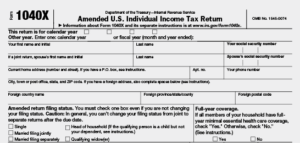 Taxpayers who discover an error after filing may need to amend their tax return. Taxpayers should file an amended return if there’s a change in filing status, income, deductions or credits.
Taxpayers who discover an error after filing may need to amend their tax return. Taxpayers should file an amended return if there’s a change in filing status, income, deductions or credits.
The IRS may correct mathematical or clerical errors on a return. They also may accept returns without certain required forms or schedules. In these instances, there’s no need to file an amended return.
Taxpayers who need to amend should remember these simple tips:
- Use the Interactive Tax Assistant. The ITA titled Should I File an Amended Return? can help taxpayers determine if they should file an amended return to correct an error or make other changes to their original return.
- Wait to file for corrected refund for tax year 2018. Taxpayers who are due refunds from their original 2018 tax return should wait to get it before filing Form 1040-X to claim an additional refund. Amended returns may take up to 16 weeks to process.
- File on paper. Taxpayers use Form 1040-X, Amended U.S. Individual Income Tax Return, to correct their tax return. Taxpayers can’t file amended returns electronically. Taxpayers will mail Form 1040-X to the address listed in the form’s instructions. However, taxpayers filing Form 1040-X in response to an IRS notice, should mail it to the address shown on the notice.
- Amend to correct errors. Taxpayers should file an amended tax return to correct errors or make changes to an original tax return. For example, taxpayers should amend their return to change their filing status. They should also file a 1040-X to correct their income, deductions and credits.
- Don’t amend for math errors. Taxpayers generally don’t need to file an amended return to correct math errors on their original return. The IRS will automatically correct these.
- Don’t amend for missing forms. Taxpayers also don’t need to file an amended return if they forgot to attach tax forms. The IRS will mail a request to the taxpayer for missing forms.
- File within three-year time limit. Taxpayers usually have three years from the date they filed the original tax return to file Form 1040-X to claim a refund. Taxpayers can file it within two years from the date they paid the tax, if that date is later.
- Pay additional tax as soon as possible. Taxpayers who will owe tax should file Form 1040X and pay the tax immediately to avoid potential penalties and interest on the unpaid taxes. They should consider using IRS Direct Pay to pay any tax directly from a checking or savings account at no cost.
- Track amended return. Generally, taxpayers can track the status of their amended tax return three weeks after they file, using Where’s My Amended Return? on IRS.gov.
